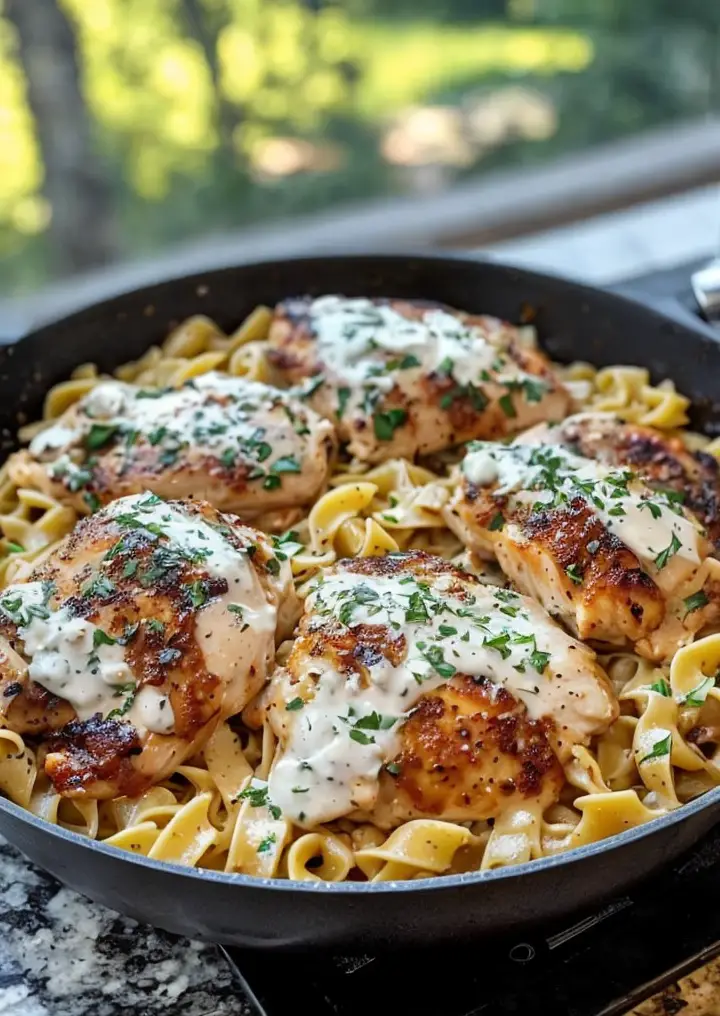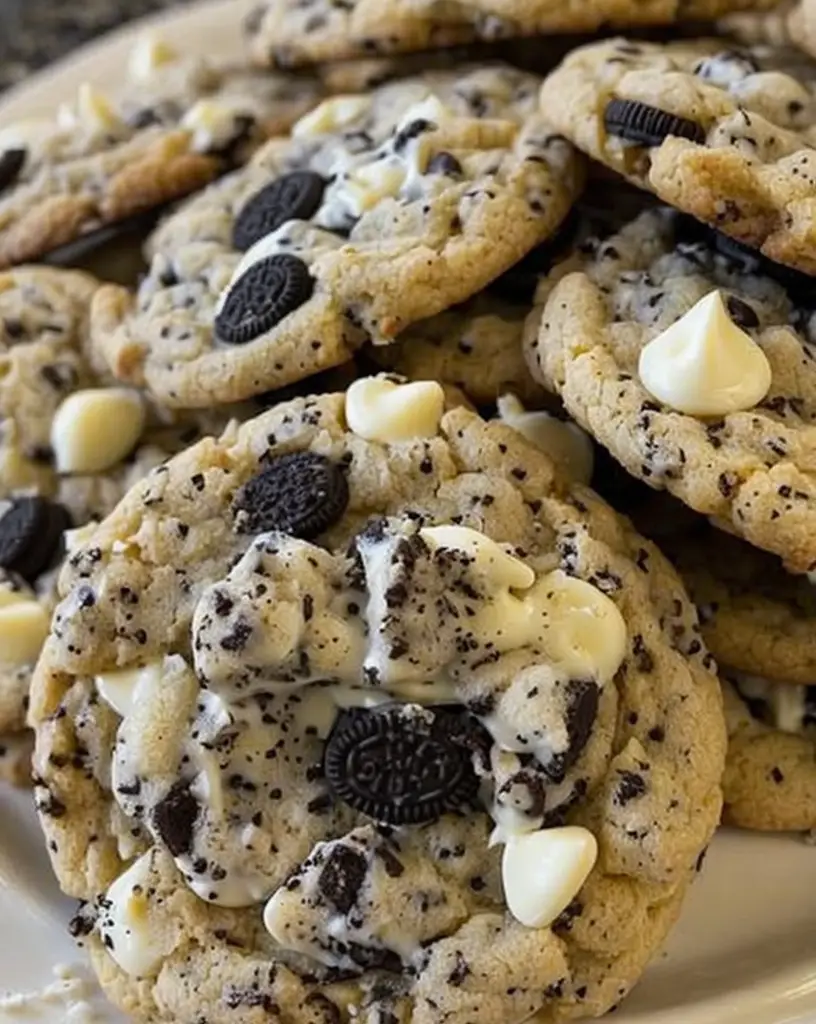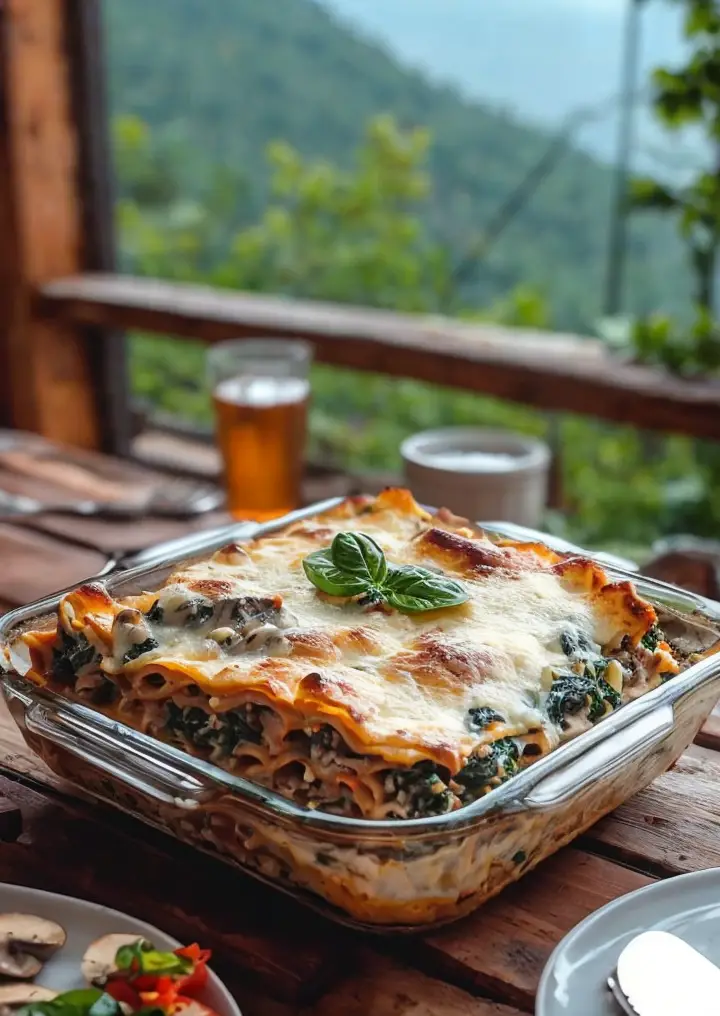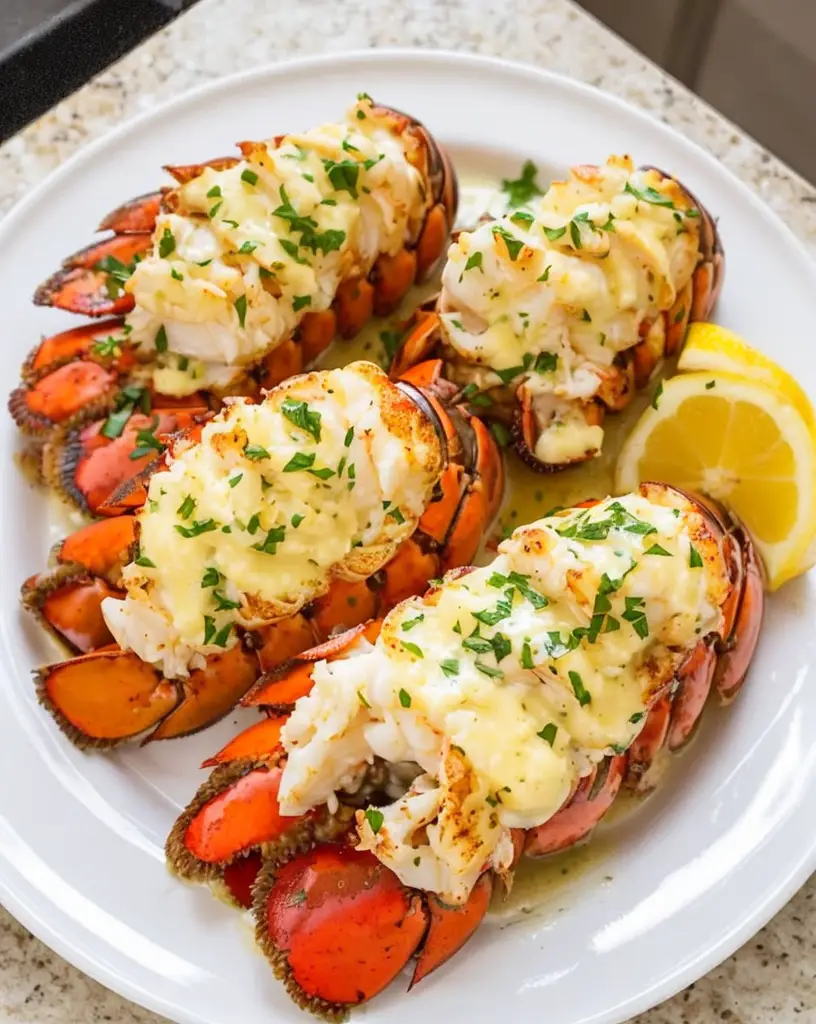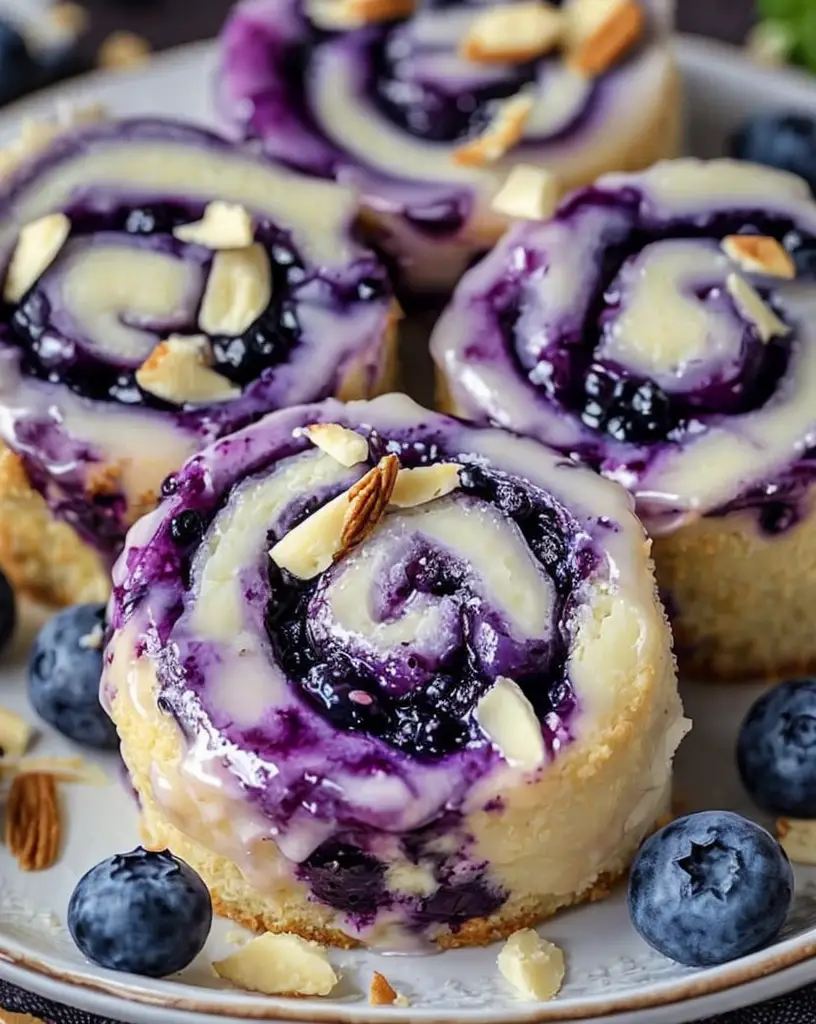One-Pan Chicken with Buttered Noodles | Perfect for Busy Nights!
One-Pan Chicken with Buttered Noodles is the ideal meal for busy nights when you crave home-cooked comfort but lack time. This dish combines tender chicken seasoned to perfection with buttery noodles, all cooked in the same pan for maximum flavor and minimal cleanup. The creamy texture of the noodles complements the juicy chicken, making every bite a delight. It’s not just a meal; it’s a soothing experience that transforms your hectic day into a relaxing evening, allowing you to savor the moment with family or friends.
Imagine sitting down to a plate of perfectly cooked chicken alongside a mound of buttery, garlicky noodles. The aromas of garlic and fresh herbs waft through the air, instantly making your kitchen feel warm and inviting. This dish doesn’t just look appealing; it tastes even better. The simplicity of the ingredients highlights their natural flavors, creating an inviting meal sure to satisfy everyone around the table.
Quick Recipe Highlights
- Flavor Profile: The dish features a savory blend of garlic, herbs, and buttery richness that enhances the chicken’s natural flavor, creating a comforting meal perfect for any night.
- Texture: The contrast of the tender, juicy chicken paired with the silky, smooth noodles makes for an incredibly satisfying dining experience.
- Aroma: Key aromatic notes include garlic, which adds warmth, and fresh herbs that invigorate your senses.
- Visual Appeal: The bright, golden chicken juxtaposed against the rich, glossy noodles creates an inviting plate that begs to be devoured.
- Skill Level Needed: This is an easy recipe, making it accessible for cooks at any skill level, particularly those just starting.
- Special Equipment: No special equipment is needed—just a sturdy skillet or pan and basic cooking utensils.
Recipe Overview
- Difficulty Level: Easy to moderate, this recipe requires basic cooking skills, making it suitable for beginner to intermediate cooks. It allows for greater exploration while not being overly complicated.
- Category: This dish fits perfectly into the comfort food category, offering a hearty option that’s gratifying after a long day.
- Cuisine: While influenced by American home cooking traditions, this dish has elements typical of many Western cuisines, focusing on simplicity and flavor.
- Cost: The ingredients are economical, making this a budget-friendly meal option ideal for families and those keeping a close eye on their grocery bills.
- Season: Perfect year-round, this recipe shines brightly in the cooler months as a cozy meal while still being light enough for spring and summer enjoyment.
- Occasion: This is versatile enough for a weeknight dinner, family gatherings, or when hosting friends for a casual get-together.
Why You’ll Love This Recipe
One-Pan Chicken with Buttered Noodles brings together a wonderful balance of taste and texture that warms the heart. The savory chicken pairs beautifully with the rich, buttery noodles—an established combo that never fails to delight. Each bite introduces a blend of comforting flavors that make it hard to stop coming back for more. Whether you’re served at the dinner table or packed in lunches, this recipe provides joy in each mouthful.
In addition to its taste, the convenience of this recipe makes it a favorite for busy weeknights. With everything cooked in one pan, cleanup time is significantly reduced. You won’t have to spend your post-dinner hours scrubbing pots and pans. Instead, you can unwind and enjoy the leftovers or share the meal with family. The ease of preparation means you can whip up a delicious dinner in no time, making those evenings less stressful and more enjoyable.
Moreover, this dish packs a nutritional punch without sacrificing flavor. The chicken provides a good source of protein, which is essential for muscle health and satiety. Meanwhile, the pasta offers carbohydrates for energy, and with well-chosen herbs and spices, you can infuse flavors that support health. This makes it a great option for families looking to maintain a balanced diet.
Sharing meals like One-Pan Chicken with Buttered Noodles fosters connection and joy. Whether it’s a simple weeknight dinner or a gathering with friends, this recipe encourages togetherness and conversation over good food. The aromas wafting from the kitchen create a warm atmosphere, inviting everyone to sit down and enjoy each other’s company.
Not to mention, the cost-effectiveness of the recipe is a major plus. Using common pantry staples keeps it budget-friendly, allowing you to indulge without breaking the bank. Perfect for anyone who loves delicious food but is mindful of spending, this chicken and noodles dish is a reliable choice that meets various needs.
Historical Background and Cultural Significance
While One-Pan Chicken with Buttered Noodles seems like a modern creation, dishes like these have been staples in kitchens for generations. The concept of cooking a protein with a starch in one pot is rooted deep in culinary history, as it embodies simplicity and functionality that home cooks cherish. Roots can be traced back to the necessity of creating filling meals using minimal resources.
This dish has held cultural significance as a symbol of comfort food in American homes. Families have gathered around similar meals, sharing stories and making memories over hearty portions that fuel both body and soul. Each bite encapsulates warmth—a reminder of home-cooked meals during childhood, reinforcing bonds that last a lifetime.
Over time, recipes for chicken and buttered noodles have evolved, adapting to changing tastes and available ingredients. Regional variations have emerged, showcasing local flavors and techniques that personalize the dish further, making it unique to different households.
Today, a resurgence in one-pan meals reflects modern cooking trends that prioritize convenience and simplicity. One-Pan Chicken with Buttered Noodles illustrates that traditional recipes can flexibly adapt to today’s fast-paced lifestyle while still delivering the comfort and satisfaction we crave.
Ingredient Deep Dive
– **Chicken:** The star of the dish, chicken has been an essential protein source in cultures around the world. Nutritionally, it is rich in protein, vitamins, and minerals, supporting overall health. When selecting chicken, look for firm, moist pieces with no discoloration. Store it in the fridge for a day or two or freeze it for later use. For variations, dark meat can be used for a juicier experience.
– **Noodles:** Noodles, in various forms, are a staple in many cuisines, and their carbohydrate content provides energy. Choose quality pasta made from durum wheat for the best texture. Store dried noodles in a sealed container in a cool place. Consider whole-grain or gluten-free noodles for varied dietary preferences and health benefits.
– **Butter:** Essential for the sauce and noodles, butter adds richness and flavor. Made from churned cream, it has fat that enhances the dish’s mouthfeel. Use unsalted butter to control saltiness. Store butter in a cool, dark place, and when used in moderation, its deliciousness blooms in cooking, encouraging other flavors to shine.
– **Garlic and Herbs:** Garlic adds depth, while herbs like parsley provide freshness. Garlic possesses numerous health benefits, including immune support. Choose fresh, firm cloves for the best flavor and store them in a cool, dry place. Fresh herbs can enhance the dish’s aroma and visual appeal, offering additional health benefits. Substitutions, like garlic powder or dried herbs, can be understood based on availability.
Common Mistakes to Avoid
- Not seasoning the chicken adequately: Under-seasoned chicken will not provide the flavor depth expected for the dish. Ensure to season well before cooking.
- Overcooking the noodles: This can lead to a mushy texture that detracts from the dish’s overall appeal. Cook just until al dente for the best results.
- Using too much butter: While butter adds richness, too much can make the dish overly greasy. Stick to the recommended amounts for the right balance.
- Skipping the resting time for chicken: Allowing chicken to rest before slicing lets juices redistribute, resulting in juicier meat. Avoid cutting it immediately after cooking.
- Neglecting to use a preheated pan: A hot pan helps to sear the chicken properly, creating a nice crust and locking in flavors. Always preheat to achieve the best results.
- Crowding the pan: Placing too much chicken in the pan at once can hinder proper cooking, leading to steaming rather than browning. Cook in batches if needed.
- Not using enough liquid for the noodles: Ensure there’s enough broth or water to give your noodles the right flavor and prevent them from drying out.
- Forgetting aromatics: Garlic and fresh herbs enhance flavor profiles significantly. Always add them in the right sequences to avoid burning.
- Using the wrong type of noodle: Different noodles cook at different rates. Ensure to select the correct type to match cooking times with your chicken.
- Rushing the cooking process: Good flavors develop over time. Resist the urge to rush, and allow chicken to cook through thoroughly.
Essential Techniques
– **Searing Chicken:** Searing creates a delicious crust that enhances flavor. To master it, ensure your pan is hot and use enough oil. Watch for golden-brown color; it indicates a proper sear.
– **Cooking Noodles:** For perfectly cooked noodles, check the package instructions and taste for doneness. Frequently stirring helps prevent sticking and ensures even cooking.
– **Deglazing:** This technique helps incorporate fond – the brown bits stuck to the pan – into the sauce. Adding broth or wine while scraping the pan creates a deeper flavor profile.
– **Resting Protein:** Allowing chicken to rest post-cooking is crucial for texture and juiciness. Resting redistributes juices, so the meat retains moisture when sliced.
Pro Tips for Perfect One-Pan Chicken with Buttered Noodles
– Marinate the chicken in lemon juice and herbs for added flavor before cooking; this will enhance tenderness and infuse extra taste.
– For an extra touch, use freshly grated Parmesan cheese over the finished dish for a rich and creamy finish.
– Consider adding seasonal vegetables like spinach or peas during the last few minutes of cooking for additional nutrients and color.
– Substitute half the butter with olive oil for a healthier alternative without sacrificing flavor.
– Use chicken thighs instead of breasts for a juicier and more flavorful result.
– When cooking, use a lid to cover the pan briefly; this helps the chicken cook evenly without drying out.
– For a spicier touch, add red pepper flakes or cayenne pepper into the buttered noodles for a bit of heat.
– Experiment with different herbs such as thyme or rosemary for a variance in flavor that works with the chicken and butter noodles.
Variations and Adaptations
– **Regional Variations:** In Italy, similar dishes may feature a cream sauce with various herbs, reflective of local flavor profiles. Techniques from Italian cooking could easily adapt this dish into a pasta primavera or alfredo style.
– **Seasonal Adaptations:** For a seasonal twist, incorporate roasted vegetables like butternut squash in the fall or fresh zucchini in the summer, complementing the dish perfectly.
– **Dietary Modifications:** For gluten-free diets, alternative noodles such as rice or quinoa noodles can substitute for standard pasta, maintaining the dish’s beloved features without the gluten.
– **Flavor Variations:** Adding different sauces like teriyaki or buffalo sauce can give the dish a completely new flavor profile, appealing to various taste preferences.
– **Texture Modifications:** For added crunch, you could toss in toasted nuts or seeds just before serving.
– **Presentation Alternatives:** Serve the dish in a large family-style bowl for gatherings, garnished with freshly chopped herbs for colorful appeal.
Serving and Presentation Guide
Serving One-Pan Chicken with Buttered Noodles beautifully elevates the dining experience. Start by plating the chicken on a bed of noodles, drizzling the sauce over the top, and scattering freshly chopped herbs or spring onions for a burst of color. Consider using wide, shallow bowls or rustic plates to emphasize the homey feel.
Garnish with a sprinkle of freshly grated cheese or a drizzle of olive oil for added richness. Pair with a simple green salad dressed lightly to contrast the hearty dish. The use of warm, inviting dinnerware also contributes to a delightful presentation, enhancing the meal’s visual and sensory appeal.
Ensure to serve the dish warm, allowing for the ideal tasting experience. Discuss portion sizes with guests, providing more for those who appreciate seconds, while offering smaller portions for light eaters.
Wine and Beverage Pairing
Pairing wine with One-Pan Chicken with Buttered Noodles enhances the meal’s overall enjoyment. A crisp Chardonnay or a lightly oaked Sauvignon Blanc works beautifully, providing a refreshing contrast to the richness of the chicken and noodles.
For non-alcoholic alternatives, consider serving lemonade or iced herbal tea, offering a refreshing palate cleanser without overpowering the dish’s flavors. A light, tropical mocktail can also add an element of fun to the dining experience.
If coffee or tea is preferred, serve a light herbal tea that complements the meal without overshadowing it. Ensure beverages are chilled or served warm according to preference, aligning with seasonal trends.
Storage and Shelf Life
To store One-Pan Chicken with Buttered Noodles, allow the dish to cool to room temperature. Transfer portions into airtight containers, and keep them refrigerated for up to 3 days. The meal can also be frozen; however, the texture of the noodles may change upon thawing. For best results, consume frozen leftovers within 2 months.
When reheating, use the microwave or stove; add a splash of water or broth to maintain moisture. It’s vital to heat thoroughly to ensure food safety while keeping the dish delectable.
Signs of spoilage include an off smell or visible mold; always double-check before consuming leftovers to ensure they haven’t gone bad.
Make Ahead Strategies
To streamline your meal preparation, consider prepping the chicken ahead. Season and marinate in advance, allowing flavors to soak in. Alternatively, cook and cool the chicken, storing it in the fridge until needed.
Noodles can also be precooked and stored separately; simply warm them up before serving. Keeping components separate also helps maintain their textures until it’s time to enjoy.
When assembling, ensure to layer the noodles and chicken correctly to avoid mushiness. Fresh elements, like herbs or parmesan, can be added just before serving for optimal freshness.
Scaling Instructions
Halving One-Pan Chicken with Buttered Noodles is simple—just divide the ingredients and adjust cooking times slightly less than half, monitoring doneness. For larger gatherings, doubling or tripling the recipe is straightforward; however, you may need to cook in batches, ensuring even cooking and proper browning.
Adjust your equipment accordingly—using a larger pan or making two batches in separate pans may be necessary to accommodate increased volume. Timing will also vary, so keep an eye on both chicken and noodles for optimal texture and flavor.
Be mindful of how much extra storage space you will require if making large quantities ahead of time. Leftovers can always be enjoyed later!
Nutritional Deep Dive
The macros in One-Pan Chicken with Buttered Noodles consist largely of protein from chicken, carbohydrates from the noodles, and healthy fats from the butter. Tracking portion sizes plays a crucial role in meal planning, especially if you’re watching caloric intake.
Micronutrient-wise, this meal delivers vitamins and minerals from added herbs and vegetables. Leafy additions, such as spinach or parsley, can further enhance the nutritional value by adding iron, vitamin K, and other essential nutrients.
Health benefits come from the balanced macro proportions and the inclusion of proteins that support muscle recovery. Those watching their weight find this meal fitting, as it can be enjoyed in satisfying portions without unnecessary excesses.
Dietary Adaptations
– **Gluten-free:** Substitute regular noodles with gluten-free options like rice noodles or zucchini noodles to accommodate dietary needs without losing flavor.
– **Dairy-free:** Replace butter with olive oil or a dairy-free butter alternative to enjoy this dish without compromising dietary preferences.
– **Vegan:** Use tofu or seitan instead of chicken and a plant-based butter alternative to make the recipe suitable for vegans while maintaining texture and taste.
– **Low-carb:** Consider using spiralized vegetables or cauliflower rice as an alternative for noodles to reduce carbohydrate intake while still delivering satisfaction.
– **Keto:** Similar to low-carb adaptations, utilize high-fat options with additional cheeses to maintain ketogenic dietary profiles while enjoying a comforting meal.
– **Paleo:** Focus on non-processed ingredients and swap noodles with vegetable alternatives to create a dish that aligns with paleo dietary guidelines.
– **Low-FODMAP:** Choose the right noodles and limit garlic to maintain low-FODMAP compliance while ensuring the recipe remains flavorful.
Troubleshooting Guide
– **Texture Issues:** If your noodles are mushy, reduce cooking time next time or rinse with cold water after cooking to stop the cooking process.
– **Flavor Balance:** For an overly salty dish, add a touch of sugar or acid (lemon juice) to balance flavors effectively.
– **Temperature Problems:** If the chicken is overcooked outside but raw inside, use lower heat to cook more evenly in future attempts.
– **Equipment Challenges:** If you don’t have a suitable pan for serving, consider using a deep dish that can transfer easily from stovetop to table.
– **Ingredient Substitutions:** Choosing fresh over dried ingredients may intensify flavors; adjust your quantities accordingly based on your palate preferences.
– **Timing Concerns:** Start with the chicken if it takes longer to cook, allowing the rest of the dish to follow in good time without sacrificing quality.
Recipe Success Stories
Community feedback often highlights how easily adaptable One-Pan Chicken with Buttered Noodles is to individual tastes and preferences. Variations using different herbs or pasta types have led to many fan-favorite adaptations.
Readers have praised this recipe for its simplicity and robust flavors, often bringing forth suggestions to incorporate their latest kitchen experiments, enhancing the overall dish. Many have shared their photography tips, showcasing the beautiful presentation of their finished meals and encouraging others to join the fun.
Sharing stories of how this recipe has become a go-to for busy nights reflects its resonance with many home cooks, emphasizing that good food can still be simple and nourishing.
Frequently Asked Questions
A: Yes, you can marinate the chicken beforehand and store it in the fridge. Cooked portions can also be reheated, making this a convenient choice for meal prep.
Q2: How do I store leftovers?
A: Store in airtight containers in the refrigerator for up to three days. For longer storage, freeze portions for up to two months.
Q3: Can I use frozen chicken for this recipe?
A: It’s best to thaw chicken beforehand to ensure even cooking. However, if using frozen chicken, you’ll need to adjust the cooking times accordingly.
Q4: What’s the best type of noodles to use?
A: While traditional egg noodles are recommended, you can also use whole grain, gluten-free, or vegetable noodles based on your dietary needs.
Q5: Can I add vegetables to this dish?
A: Absolutely! Feel free to add vegetables like spinach, bell peppers, or broccoli for additional flavor and nutrients.
Q6: What can I do if the noodles are sticky?
A: Stir the pasta frequently while cooking and rinse with cold water after draining to prevent sticking in future recipes.
Q7: Do I have to use butter?
A: While butter enhances flavor, you can use olive oil as a healthier alternative or to suit dairy-free diets.
Q8: Can I make this dish in the oven?
A: Yes, you can bake the chicken and then cook the noodles separately, but adjust cooking times to ensure both are done perfectly.
Q9: How can I make this dish spicier?
A: Add red pepper flakes or cayenne pepper to the noodles for a kick of flavor that complements the savory ingredients.
Q10: Is this dish freezable?
A: Yes, this dish freezes well; however, the texture of the noodles might change. It’s best enjoyed fresh or properly reheated.
Additional Resources
Explore related recipes like One-Pan Lemon Garlic Shrimp or Garlic Butter Pasta for more delightful, easy dinners. Techniques such as knife skills or marinating will refine your cooking approach while enhancing flavor profiles.
For ingredient information, understanding the benefits of fresh herbs or selecting quality chicken can take your dishes to the next level. Check out seasonal variations for fresh ideas, such as adding seasonal vegetables to balance tastes during warmer months or full-flavored add-ins for winter meals.
Join the Conversation
We invite you to share your culinary journey with One-Pan Chicken with Buttered Noodles. Share photos on social media using our hashtag, or leave a comment about your own variations and experiences. Engage with our community to gather inspiration, ask questions, and provide feedback on recipe implementations.
Your input strengthens our connection, allowing us to grow together. Join us as we explore new flavors, share successes, and celebrate our collective love for food.
The Recipe
One-Pan Chicken with Buttered Noodles
Serves: 4 servings
Prep Time: 15 mins
Cook Time: 25 mins
Total Time: 40 mins
Kitchen Equipment Needed
- Large skillet or frying pan
- Wooden spoon or spatula
- Measuring cups and spoons
- Cutting board and knife
Ingredients
- 1.5 lbs of chicken breasts, sliced
- 8 oz egg noodles
- 4 tablespoons butter
- 4 cloves garlic, minced
- 1 cup chicken broth
- 2 tablespoons parsley, chopped
- Salt and pepper to taste
- Optional: grated Parmesan cheese for serving
Directions
- In a large skillet, melt 2 tablespoons of butter over medium heat. Add the sliced chicken, seasoning with salt and pepper. Cook until golden brown and fully cooked, about 5-7 minutes. Remove chicken from the skillet and set aside.
- In the same skillet, add remaining butter and garlic; sauté until fragrant (about 1 minute). Add chicken broth and bring to a simmer.
- Add the egg noodles to the simmering broth. Stir occasionally and cook according to package instructions until al dente, about 8-10 minutes.
- Return the cooked chicken to the skillet, mixing everything together. Cook for a couple more minutes to heat through and combine flavors.
- Garnish with parsley and serve hot, topped with grated Parmesan if desired.
Recipe Notes
- Substitute chicken with tofu for a vegetarian alternative.
- Use whole wheat noodles for a more nutritious option.
- Add seasonal vegetables like peas or spinach for extra nutrition.
